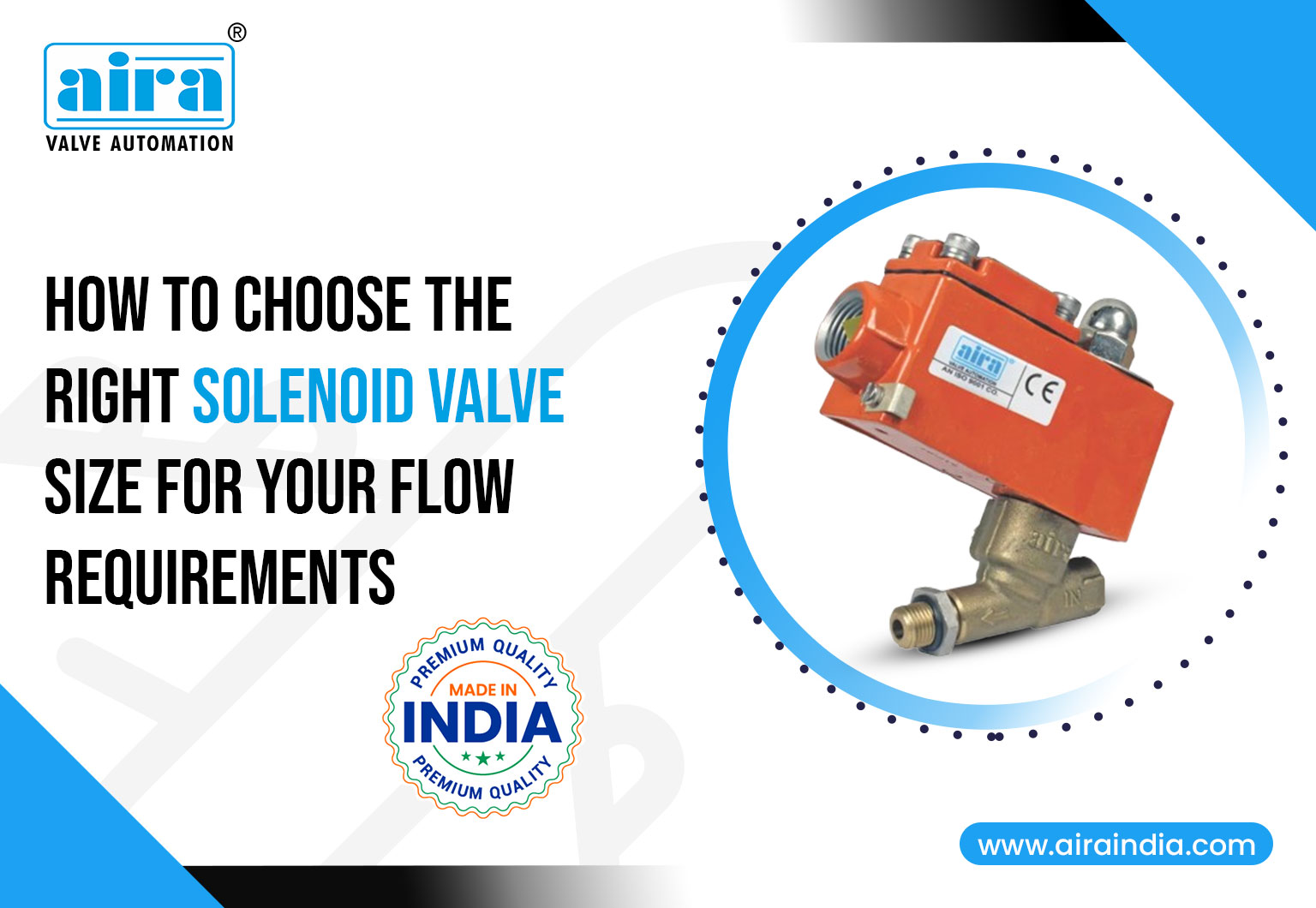When it comes to solenoid valves, size is far more than just a dimensional factor. Whether you’re planning a new industrial setup or upgrading existing equipment, proper valve sizing is critical. An oversized valve can lead to sluggish performance and wasted energy, while an undersized one can cause pressure drops, flow disruptions, or even system failure. That’s why at Aira Euro Automation, we emphasize precision in solenoid valve sizing, it directly influences flow control, safety, and long-term efficiency. In this blog, you’ll learn how to select the perfect solenoid valve size for your specific application.
Understand Your Flow Requirements
Before selecting a valve, understanding your system’s flow characteristics is essential. The starting point is identifying the type of media, whether you’re handling compressed air, water, steam, oil, or chemicals. Each medium behaves differently under pressure and temperature.
Next, determine the required flow rate, usually measured in L/min or m³/h, and note your working pressure. These two parameters form the basis of any solenoid valve selection.
While it’s tempting to choose a valve based on the pipe size, this approach often leads to sizing errors. The pipe diameter gives a general guideline, but the valve size must be aligned with flow and pressure demands, not just the line size.
Also, assess system variables like:
- Horizontal or vertical pipe orientation
- Distance from source to end-use point
- Number of downstream outlets
- Whether the application needs precise dosing or automation
All these factors contribute to choosing the right solenoid valve flow rate, capacity, and response time.
Aira’s Solenoid Valve Sizing Range & Flow Charts
As a leading solenoid valve manufacturer in India, Aira Euro Automation offers an extensive range of valve sizes and configurations to meet every application requirement. Our valves are available from ½” to 6”, in both screwed and flanged versions.
Material choices include:
- CF8 / CF8M / CF3M stainless steel bodies
- Seat materials like PTFE, Viton, PEEK, CFT, NBR, Hi-Netra, and PU for media compatibility and durability
To simplify selection, Aira provides detailed flow charts and datasheets, including Cv (flow coefficient) and Kv (flow factor) ratings, which help engineers correlate desired flow rate and pressure drop with valve size.
Engineers can refer to the Aira solenoid valve size chart for quick and accurate decision-making, and our in-house technical team is always available to validate your sizing decisions based on actual application parameters.
Direct vs Pilot Operated Sizing Logic Differs
Understanding the difference between direct-acting and pilot-operated solenoid valves is crucial, especially for sizing.
- Direct acting solenoid valves work even with zero pressure differential. Here, sizing mainly depends on the port size, and they’re ideal for low-pressure or vacuum systems.
- In contrast, pilot-operated solenoid valves require a minimum pressure differential (typically 0.5 bar or more) to operate. They offer greater flow capacity at smaller sizes, making them perfect for high-pressure or large-volume applications.
For low-pressure or gravity-fed systems, it’s advisable to size up or use a direct-acting valve to ensure reliable operation. Aira provides both types, along with expert support to help you make the right selection based on flow rate, pressure, and control response.
Whether you’re selecting a direct-acting solenoid valve or exploring pilot operated solenoid valve options, sizing principles vary, and our team ensures you get it right.
Mistakes to Avoid When Sizing Solenoid Valves
Improper valve sizing can compromise system performance and result in expensive downtimes. Here are some common solenoid valve sizing errors to watch out for:
- Sizing based solely on pipe diameter without considering the actual flow rate and pressure requirements
- Ignoring pressure drop, which can lead to poor valve responsiveness and system inefficiency
- Selecting an oversized valve, which can result in delayed actuation and energy waste
- Using an undersized valve, which may cause cavitation, flow restrictions, or valve chattering
- Neglecting media viscosity, especially in chemical or oil-based applications
- Skipping the datasheet review or consultation with a valve specialist
Avoid trial-and-error methods. Instead, rely on engineered selection using Aira’s datasheets, flow curves, and application-specific support.
Also, read General Purpose Solenoid Valves: What They Are and Where They’re Used
Why Choose Aira for Application-Specific Valve Sizing?
Choosing Aira Euro Automation means you’re partnering with a reliable solenoid valve manufacturer in India that prioritizes precision, performance, and engineering excellence.
Here’s what makes Aira the preferred choice:
- Customized valve sizing support tailored to your application
- 100% in-house manufacturing with ISO-certified quality control
- Fast prototyping and real-time testing to validate performance
- A wide inventory offering flexibility in size, materials, and sealing options
- Technical support from experienced engineers who help you match flow rates, media types, actuation methods, and pressure conditions
Our solutions are trusted by engineers and OEMs across India and abroad in industries such as water treatment, oil & gas, food processing, pharmaceuticals, chemicals, and more.
Right Size, Right Results
Getting your solenoid valve sizing right isn’t just about numbers; it’s about optimizing flow, ensuring system safety, and achieving peak efficiency. Aira Euro Automation simplifies this process with expert support, engineered tools, and robust product options.
Need help sizing your solenoid valve correctly?
Talk to Aira’s experts today and get a solution that fits your exact flow and pressure needs.
